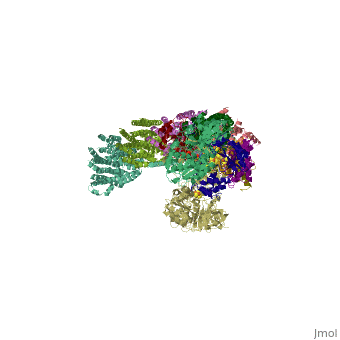NADH:ubiquinone oxidoreductase
From Proteopedia
(Difference between revisions)
| Line 1: | Line 1: | ||
==Structure== | ==Structure== | ||
| - | <StructureSection load='3m9s' size='340' side='right' caption=' | + | <StructureSection load='3m9s' size='340' side='right' caption='Thermus thermophilus complex I (PDB code [[3m9s]]).' scene=''> |
| - | + | ||
| - | + | ||
== Function == | == Function == | ||
| - | Complex I is the first enzyme of the electron transport chain. This enzyme is one of the three large chains of protein complexes that electrons are transferred through. For every molecule of NADH that is oxidized, this complex moves four protons across the inner membrane and into the cytoplasm. This helps build the electrochemical potential used to produce ATP. The reaction of this complex is NADH + Q + 5H+(matrix) → NAD+ + QH2 + 4H+(cytoplasm) | + | '''Complex I''' is the first enzyme of the electron transport chain. This enzyme is one of the three large chains of protein complexes that electrons are transferred through. For every molecule of NADH that is oxidized, this complex moves four protons across the inner membrane and into the cytoplasm. This helps build the electrochemical potential used to produce ATP. The reaction of this complex is NADH + Q + 5H+(matrix) → NAD+ + QH2 + 4H+(cytoplasm) |
==Mechanism== | ==Mechanism== | ||
Revision as of 09:25, 30 December 2014
Structure
| |||||||||||
References
Herraez A. Biomolecules in the computer: Jmol to the rescue. Biochem Mol Biol Educ. 2006 Jul;34(4):255-61. doi: 10.1002/bmb.2006.494034042644. PMID:21638687 doi:10.1002/bmb.2006.494034042644

